
Watamu, Kenya, enjoys plenty of sun almost all the time, even when the sky is cloudy. In fact, at times, there is so much sun that it is unbearable. In such situations, it is good to sit under a fan in the shade. Some might even prefer a room with air conditioning.
Reliable provision of electricity is a precondition, not only for running a fan but also for having light, internet, a fridge, and a deep freezer to run water pumps, and more (just think about hospitals for instance!). Unfortunately, one cannot rely on the permanent provision of electricity by KPLC. The Kenya Power and Lighting Company KPLC (Kenya Power) owns and operates most of the electricity transmission and distribution system in the country and sells electricity to over 9 million (see also https://kplc.co.ke/content/item/14/about-kenya-power). It holds a monopoly.
In recent years, with tourism and population in Watamu increasing while at the same time relying on a distribution network that is constantly eroding due to the lack of investment into proper maintenance in the past, there have been frequent blackouts in Watamu and across the rest of Kenya. These may occur at any time, several times a day, and even last for days.
Hotels and those who can afford it usually mitigate the problem by using generators driven by combustion engines that consume petrol or diesel fuel. These are loud and pollute the air. Others have batteries in place that are loaded when there is power and take over in the case of a power cut. Many, in particular poorer citizens, just sit in the dark.
But there are some smart people who decided to use the abundance of sun to their favor by producing their own solar energy.
This blog describes how I installed a solar system at my house in Watamu, decreasing the dependence on KPLC considerably (but not totally), while at the same time doing something good for the environment.
Disclaimer
I am not an electric engineer, and I also do not run any business that is related to solar energy. The content of this blog should not be understood as a manual to build your own solar system but rather as me sharing my experiences. Electric installations should only be done by experienced electricians and in line with applicable rules and regulations. Some installations might require permission from the authorities, e.g. grid connected installations. This blog mentions companies and persons that were involved in building my solar system. I only mentioned contacts with whom I had good experiences; I can vouch for that but not more. Note: I have no formal financial relationship with any of the companies mentioned and I did not get any benefits from mentioning their names. Should anybody find an error in this blog, kindly let me know through the comments section so that I can correct it.
Solar energy for everybody?
While there is enough sun for everybody, it is true that many Kenyans most likely do not have the means to afford a solar system such as described in this blog. It is unfortunately only for privileged people. There are, however, small, cheap, and simple photovoltaic systems that at least ensure that there is light and maybe enough energy for the fridge.

Many cannot afford even such systems that can be found at Jiji or Jumia. People who employ staff might, however, think of this as a nice Christmas bonus for staff (also a gas cooker could be a good idea, it runs more cheaply than a charcoal cooker and contributes less air pollution).
Average Kenyans will profit indirectly from an increase in private photovoltaic systems. As these systems take away some of the strain on KPLC, they will make more energy available for others.
Why to bother, will there not be nuclear energy soon?
There are talks about erecting a nuclear power plant very close to Watamu, but I hope this never happens. Nuclear power is an energy supply option that belongs to the twentieth century. Still, many countries—for instance, France or Russia—believe it is the future. And there is a lot of money to be made in nuclear energy. In the past, discussions about nuclear energy were political, sometimes almost religious discussions—some believed in it, others didn't. This narrative has changed.
Today, nuclear is by far the most expensive source of energy out of all the power options available. This concerns the capital costs and the operating costs. Nuclear power plants are technically complex and must satisfy strict design requirements, and their construction requires a lot of very highly qualified specialists and often takes many years. Some studies estimate that it can be up to 5 to 10 times more expensive to build and operate a nuclear power plant compared to a solar plant (see, for instance, https://www.ourfutureplanet.org/energy/nuclear-vs-solar/). In particular in countries such as Kenya where there is an abundance of sun and also enough space to build solar plants. It lasts between 5 and 10 years, sometimes longer to build a Nuclear Power Plant. A solar power plant with the same output can be built within a year. There is hardly any case in which the initially planned costs for a nuclear power plant were kept. In France, in 2024, a new nuclear reactor will start its test phase, 17 years after the construction started, and at a cost of 12.7 billion Euro, 4 times more than estimated when construction started...
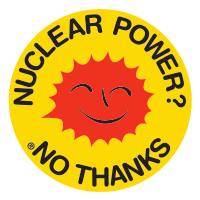
There are many more arguments against nuclear power (just imagine if an accident happens, it will be the end of tourism or fishery in Watamu, in the worst case, the end of life...), but the strongest argument is the cost argument. Investing in nuclear power, which can be up to 10 times more expensive than investing in solar with the same output, is a waste of taxpayers’ money; one might ask whether money cannot be used better, e.g. to provide free schooling for every child. Even if there are donor countries that provide financial assistance. Nothing is free in this world—and will those donor countries also provide assistance in 10 years or if there is an accident? Is financially supporting a nuclear power plant in Kenya not just a way to support the producers of obsolete technology in the donor country? As we have seen it so often...
Anyway, let’s get back to the central theme of my blog:
Starting point
When I got my house many years ago, thanks to Mr. P, the previous owner, it had a photovoltaic system in place, maybe one of the oldest in Kenya, being over 25 years old. It works with just a 500-watt panel that charges a set of batteries and when there is a blackout, it is manually switched on, taking care of the crucial electric appliances—similar to a generator. Its 12 over-25-year-old 350 Ah "Bayern Battery" lead-acid batteries still function today (the company doesn’t even seem to exist anymore...)! Not at 100% but good enough to bridge a few hours without electricity.
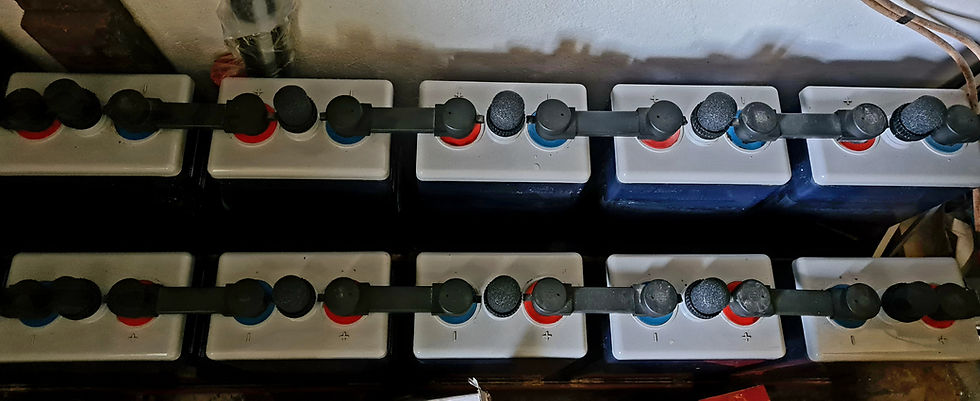

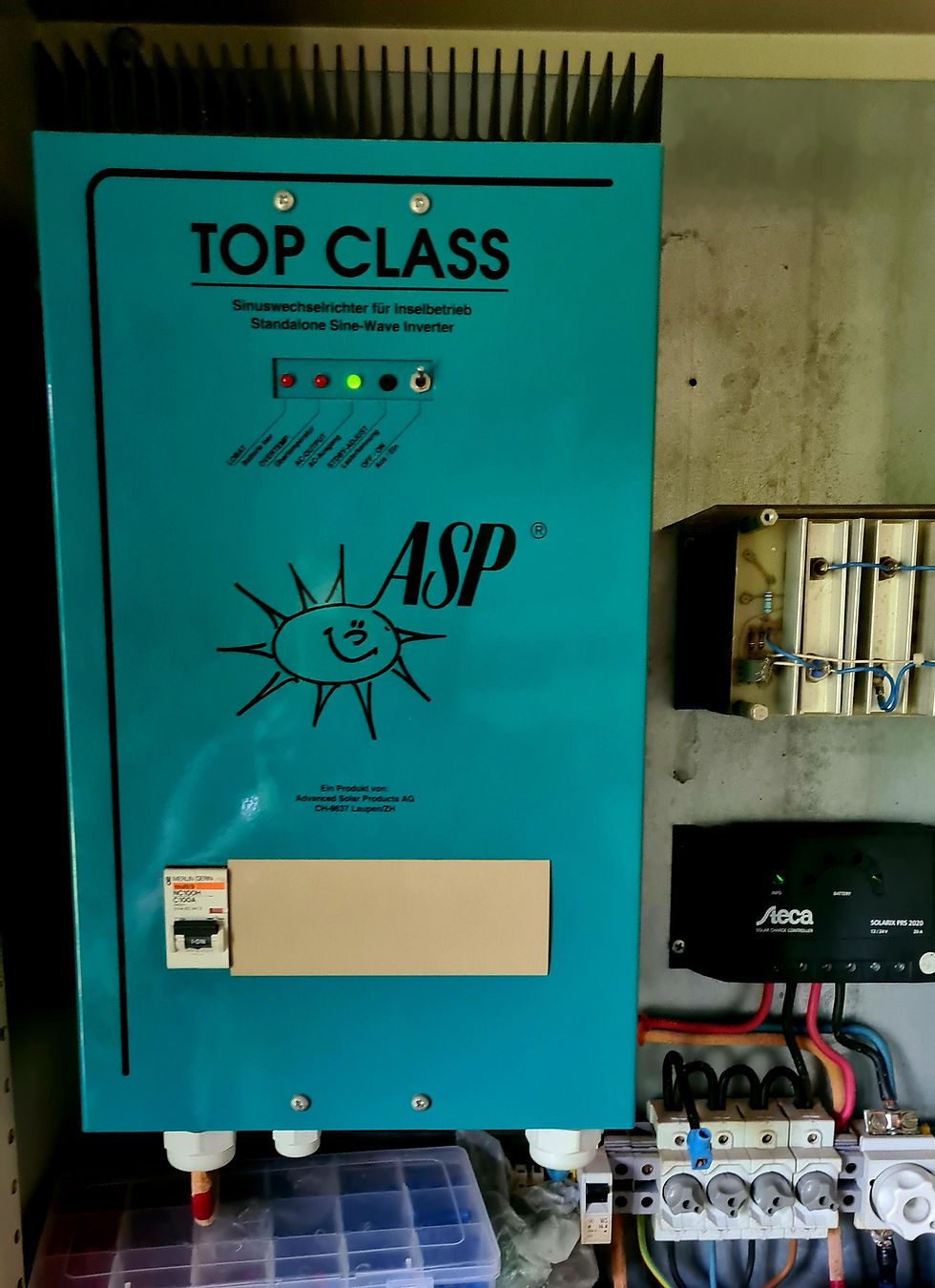
We also have a solar water heater to produce warm water (as is required by the law).
This system would have been enough if the electricity supply from KPLC were stable.
When moving to Watamu from Nairobi, I brought a battery backup system with me that we used at our house there. This system was without any solar panels, but it was possible to add those.
Thus, with the intention to do something good for the environment and given the frequent blackouts, we decided to go solar using the following approach.
The project
The old photovoltaic system will stay in place, as a kind of last reserve.
The new system will have the following components that are separate from each other:
A photovoltaic system to cover the electricity of the house using the inverter and the batteries I already had.
Another photovoltaic system to cover all electricity needs of the garage and the pool area.
Heavy power consumers, such as air conditioners and electric ovens, will be directly connected to KPLC and not to solar. This means they will not work if there is a blackout.
I decided on the latter because the consumption of the mentioned appliances is just too high to cover them with a solar system, in particular during the night, which would then need a large number of solar cells and batteries (for the night). Only one air conditioning unit might take 3000 watts, more than the rest of the house together (including lights, TV, internet, fans, etc.).
As mentioned above, a fan is a good alternative to air-con, it is cheaper and consumes considerably less energy.
For the work, I used my "Watamu electrician" Julius (+254 727 469193), who brought in help if needed, and a team from Go-solar in Nairobi, from where I also bought some of the equipment needed (more details to follow). Advice by WhatsApp was also given by my Nairobi electrician, Peter (+254 723 461320).
1. Solar power for the House
I decided to leave the old solar system in place as it is, as a last reserve if all fails.
From Nairobi, we brought:
A Victron inverter
A set of batteries
The Victron inverter was "solar ready" and had a capacity of 3000 watts. The batteries are still in good shape. Enough to get you through a night.
In Nairobi, the inverter was programmed so that it switched to batteries in case there is a power cut. This happens so fast that one barely notices and usually appliances just continue to function as if nothing happened. Sometimes, I was not even sure if we ran on KPLC or batteries...
For Watamu, the programming of the inverter will be changed so that power for the house is provided by batteries (that will be loaded during the day by solar panels) and switches (automatically) to KPLC only when the batteries are empty. It is my hope that we will not get into a situation in which batteries are drained and at the same time there is no KPLC. If yes, we still have the old system as a backup (and to be honest, I also have an old generator around that has not been used for years, but still works, because it got regular servicing...).
Additional items we needed included:
6 Jinko 560-watt solar panels
Victron Smart Solar MPPT 150/100-tr controller
Surge Protector 40 KA
32A 550 V Double Pole MCP circuit breaker
Cables, connectors, fuses, fuse boxes, etc.
While the Victron Inverter that I bought a few years ago together with the batteries was bought from Chloride Exide, I bought these items from Solar Store Kenya (Milestone Business Centre, Northern Bypass, Suite C9, 2nd Floor, Opposite New K.U Referral Hospital. Nairobi 1718 – 01000, https://solarstore.co.ke/, Tel: +254 768 016 141, Email: sales@solarstore.co.ke)

Solarstore also did some installations in Watamu. I decided to buy the items from them after checking several companies online. Their prices were ok and when talking to them, I got the impression that they were competent. They also offer full solar solutions, including installation. I did not go for that because I had already some equipment in place and I find it important to use the local workforce where possible.
Allow me to mention that for any solar project, it is of utmost importance to compare prices (unless money does not matter). Otherwise, you risk paying double or even three times as much as you should. In terms of services or installation costs, it is like when repairing a car. The official Volkswagen dealer will charge you much more than the local mechanic, who might still be as good.
The six Jinko panels I had already bought in Nairobi some time ago from Go-solar (Applewood Building, Ngong Road, opposite Adams Arcade, Nairobi, PO BOX: 74231 00200, Nairobi, Phone: +254 721 207949, Phone: +254 795 929462, Email: sales@gosolarltd.com https://gosolarltd.com/)

I would have bought more items from Go-solar, but they were not very responsive in my recent communication.
I decided to go for Jinko panels after receiving the advice (confirmed by some online research) that they are the best compromise between price and quality. It is certainly possible to get cheaper panels, these are mostly no-name, and it seems at times of doubtful quality.
Another company that offers full solar systems in Watamu is Davis and Shirtliff. Their advantage is that they have an office in Watamu (Jacaranda Road next to Watamu Properties, close to Blue Marmalade, Telephone +254 719 629 572, +254 719 310 683, Email:awatamu@dayliff.com).
Batteries
There are different ways to store the energy collected by solar panels to be used during the night or on very cloudy days. The most popular are:
Lead-acid batteries, e.g., used in cars.
Lithium batteries, e.g., used in mobile phones and laptops.
Supercapacitors. They are relatively new on the market, and they promise energy storage without major deterioration of the storage capacity over a very long period of time.
In terms of costs, supercapacitors are the most expensive, while lead-acid batteries are the cheapest. In each category, there are different models, e.g. maintenance-free lead-acid batteries or gel batteries. For my system, I chose lead-acid batteries not only because of costs but also because I have had good experiences with them in the past. It is possible to recycle lead-acid batteries.
A place for the appliances
The classic approach is to put solar panels on the roof and to have the other components and batteries in the house. However, I decided to have the panels on the ground and the equipment in a small shed that we built specially—burglarproof and with an alarm system and CCTV. The reason for building the shed close to the solar panels is that it is good to keep the length of the cables from the panel to the batteries (DC) short and it is not a problem for the inverter and the house/consumers (AC) to be far away from each other.

First, we put cables from the house to the inverter room and back, thus connecting the inverter to the house appliances and KPLC. This was done by my Watamu electrician Julius and his team.

Then, we installed the batteries and the inverter as well as the old generator in case nothing else worked. The rather heavy generator was brought in "Kenyan style"...
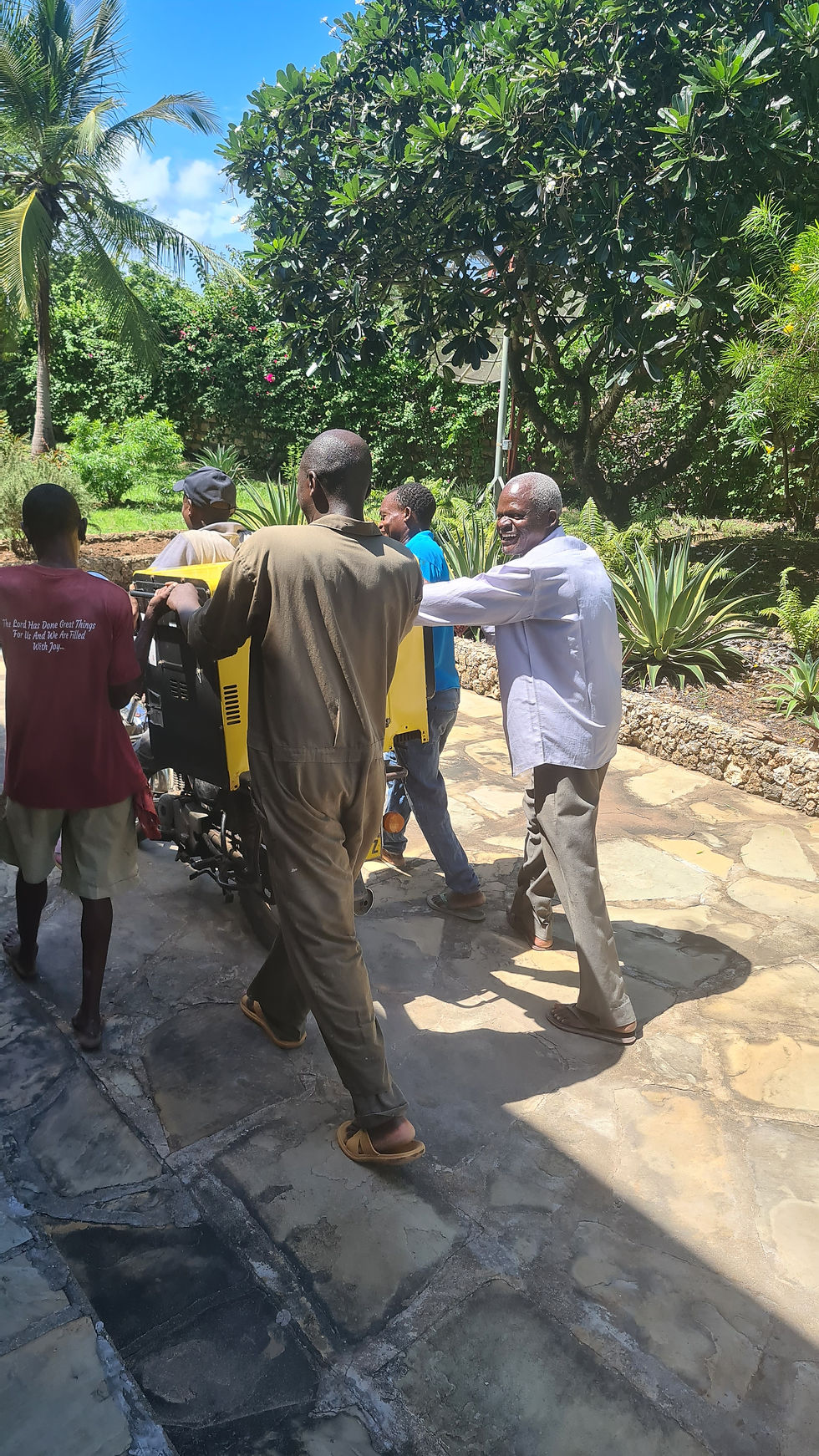

With all this in place and connected, the first step was putting an automatic backup system in place that switches to batteries if there was no Kenya Power. This was already huge progress. Basically, we often only understood that there are electricity problems when looking at the Watamu Power WhatsApp group...
After a small break, we continued erecting the structure for the solar panels.
The Solar Panels
The solar panels were placed on a structure, roughly 2m high. Such a structure could, in theory, also be used for other purposes like a carport. However, the terrain where we erected it does not allow for this.
It is ideal to use aluminum to make such a structure. We decided, however, to use the metal poles (including old, galvanized water poles) that we had and that we cleaned from rust and treated with primer and marine paint. We put a layer of rubber from old car tubes between the aluminum of the panels and the frame to avoid direct contact between the two metals. The poles were filled with cement. For the construction work, we used a local Watamu welder and his crew. Given that most materials were in place, costs for this were not that high.
After a short break, we continued by adding the panels to the construction and connecting them to the Victron controller and the batteries. The system started to produce energy immediately, and with this, the first part of the project was done.
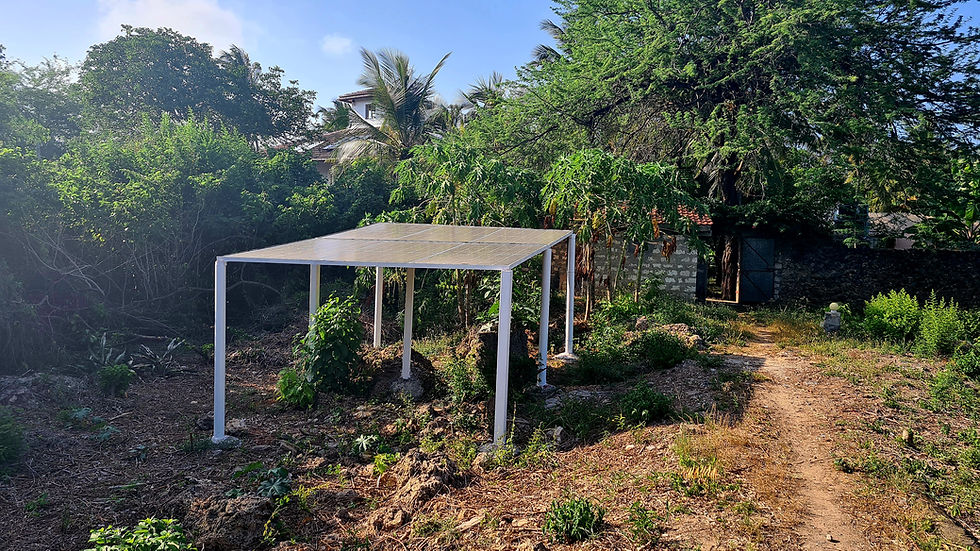
2. A separate solar system for the pool area
The reason my system is split is that I had already an inverter and batteries that I used in Nairobi. It only has 3000 watts, thus it is not enough to cover everything. For that reason, I decided to install a second system to supply solar energy for the pool area and the garage, where I need energy mainly during the day.
I bought the following items from SolarStore (see above). They did the installation too:
Riiosun 3 kW low frequency hybrid solar inverter
5 Jinko 550 monocrystal solar panels
Aluminum mounting structure for the roof
Two 100ah 12 gel batteries
Plus, sundries such as cables, switches, and fuses.
Solar Store did the installation within 2 days, sending a team of three from Nairobi. Labor costs were at 20% of the total cost of the materials—around 60,000 Ksh.

The system will cover the pool pump (750 watts), lights and fans in the pool area, and the lights in and around the garage. I opted for having only 2 relatively small batteries because most of the usage is during the day. After a test period of a few months, I will know if those two batteries are enough. If not, I will add some more. 2500 watts of solar panels should also be enough to ensure electricity during cloudy days.
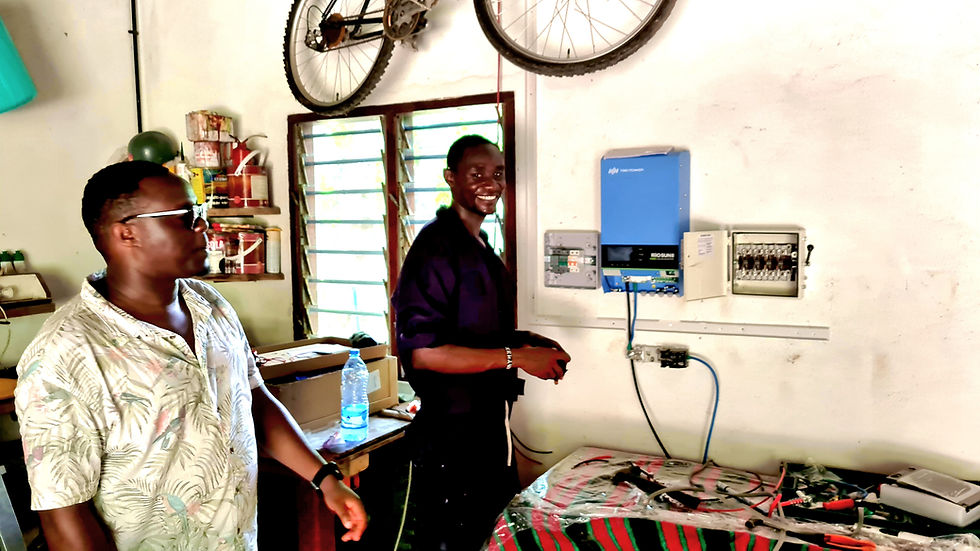
After we connected the system to the pool area, it instantly started working. The energy produced by the solar panels is enough to keep the pool pump running, even on cloudy days, as well as running a few fans. Whether the energy stored in the batteries is enough to cover the light at night remains to be seen. The system is programmed so it has KPLC as a backup, meaning that it will automatically switch to KPLC when batteries are empty.
I will report back on my experiences after a few weeks.
To be continued...
Proofreading and language editing done by Ariane L. Smith
-transformed.png)



















Comments